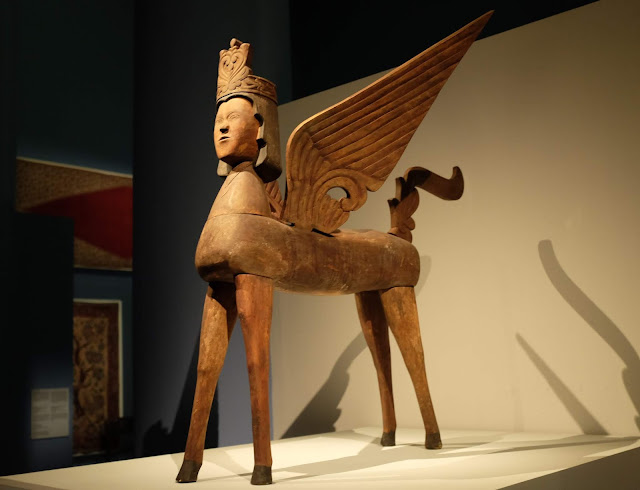Antiquities of Southeast Asia at the National Museum of the Philippines in Manila, Philippines
Antiquities of Southeast Asia at the National Museum of the Philippines in Manila, Philippines.
The National Museum's collection of antiquities date from the Paleolithic Period to about 1,000 CE. Artifacts range from stone tools to jewelry and ceramics including an assortment of burial jars. Jar burials are thought to have originated in southern China and were brought to the Philippines as early as 895 CE. One such jar found in the early 1960’s in Manunggul Cave, Lipuun Point, Palawan has an upper part as well as the cover incised with curvilinear scroll designs and painted with natural iron or hematite. On top of lid is a boat with two human figures representing two souls on a voyage to the afterlife. The boatman is seated behind a figure whose hands are crossed on the chest, a traditional funerary pose. Later burial jars dating from 5 BCE to 225 CE feature head-shaped covers displaying different facial expressions such as sadness, joy, or contentment. Some are depicted with earrings and others with tatoos. The collection also includes early Islamic art such as a winged Buraq sculpture. A Buraq in the Islamic tradition is a mythological hybrid related to Mesopotamian protective deities like the Assyrian shedu. Hadith accounts describe a Buraq carrying the prophet Muhammad from Mecca to Jerusalem.
Image: A wooden sculpture of a Buraq from Mindanao, Philippines. Image courtesy of Wikimedia Commons contributor Jnzl.
The National Museum's collection of antiquities date from the Paleolithic Period to about 1,000 CE. Artifacts range from stone tools to jewelry and ceramics including an assortment of burial jars. Jar burials are thought to have originated in southern China and were brought to the Philippines as early as 895 CE. One such jar found in the early 1960’s in Manunggul Cave, Lipuun Point, Palawan has an upper part as well as the cover incised with curvilinear scroll designs and painted with natural iron or hematite. On top of lid is a boat with two human figures representing two souls on a voyage to the afterlife. The boatman is seated behind a figure whose hands are crossed on the chest, a traditional funerary pose. Later burial jars dating from 5 BCE to 225 CE feature head-shaped covers displaying different facial expressions such as sadness, joy, or contentment. Some are depicted with earrings and others with tatoos. The collection also includes early Islamic art such as a winged Buraq sculpture. A Buraq in the Islamic tradition is a mythological hybrid related to Mesopotamian protective deities like the Assyrian shedu. Hadith accounts describe a Buraq carrying the prophet Muhammad from Mecca to Jerusalem.
Image: A wooden sculpture of a Buraq from Mindanao, Philippines. Image courtesy of Wikimedia Commons contributor Jnzl.




Comments
Post a Comment